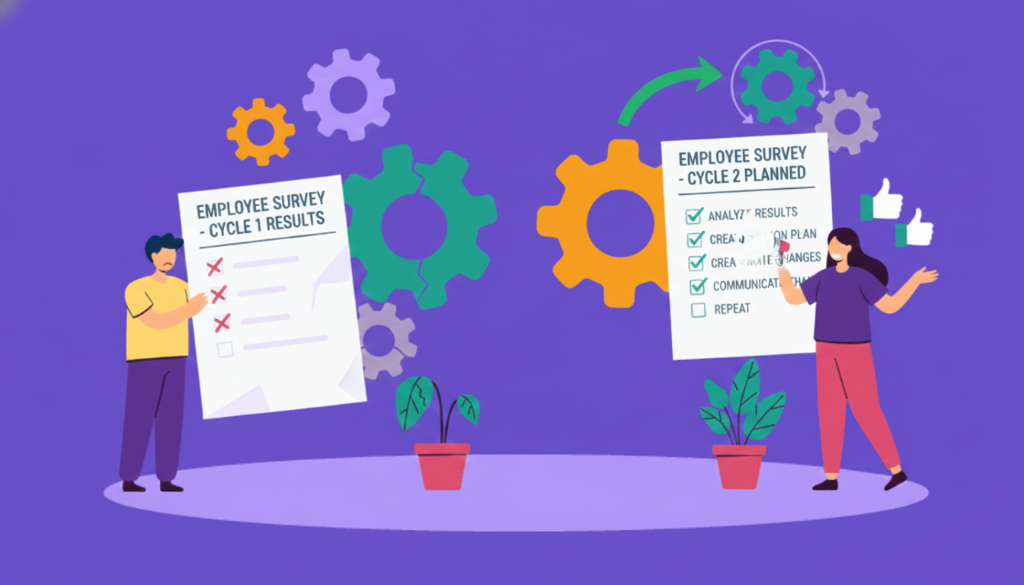Maximizing Insights: How To Analyze Employee Engagement Surveys Effectively

A Global Employee Recognition and Wellness Platform
Are you curious about what your employees are truly thinking? Employee engagement surveys are the key to uncovering these insights. As companies increasingly recognize the value of an engaged workforce, employee engagement surveys have become an essential tool for gathering insights and driving positive change. However, collecting data is just the beginning—the true value emerges when you delve into the analysis.
This comprehensive guide aims to provide HR professionals and leaders with a structured approach to employee engagement survey analysis. We will explore the significance of these surveys in the modern workplace, go through the key metrics that offer valuable insights, and outline a systematic process for translating data into actionable strategies.
Why Conducting Employee Engagement Surveys is Crucial ?
“Employee engagement is about how emotionally committed employees are to their organization and its goals. Engaged employees are more than just satisfied with their jobs; they're enthusiastic about their work and willing to go the extra mile to help the company succeed".
According to Gallup, engaged employees outperform unengaged employees by a staggering 147%; this shows how important monitoring and improving employee engagement is and how it plays a vital role in the success of any organization.
Such research consistently shows that companies with highly engaged employees experience:
- Higher productivity and profitability
- Better customer satisfaction rates
- Lower turnover and fewer absences
- More innovation and creativity
- Improved safety records in relevant industries
Regular employee engagement surveys are crucial for several reasons:
They Take the Pulse of Your Organization: Surveys give you a snapshot of your organization's overall health from your employees' perspective.
They Identify Problem Areas: Surveys help pinpoint specific issues where employees are struggling or dissatisfied.
They Help You Track Progress: Regular surveys allow you to measure the effectiveness of your engagement initiatives over time.
They Give Employees a Voice: Surveys provide a platform for employees to share their opinions and feel heard, which can boost engagement.
They Enable Data-Driven Decisions: Survey insights help HR and leadership make informed decisions about policies, programs, and workplace culture.
Engaged employees are your competitive advantage. They're more innovative, provide better customer service, and are less likely to jump ship. But you cannot improve what you don't measure, and that's where engagement surveys come in.
Recommended Read: How to Design an Employee Survey: Best Practices and Tips
Key Metrics: Your Engagement Vital Signs
When analyzing your employee engagement survey results, it's essential to focus on key metrics that provide the most valuable insights into your organization's health. While specific metrics may vary depending on your organization's goals and survey design, several core areas are generally considered crucial:
Employee Satisfaction: This measures how content employees are with their jobs, work environment, and the organization. It's a fundamental indicator of overall engagement.
Employee Loyalty: It gauges how likely employees are to stay with the organization long-term. It can be measured through questions about intent to stay or the likelihood of recommending the company as an employer.
Employee Motivation: Helps assesses what drives employees to perform their best work. It can include factors like a sense of purpose, recognition, and growth opportunities.
Work-Life Balance: This measures how well employees feel they can manage their professional and personal lives.
Trust in Leadership: This evaluates employees' confidence in the organization's leadership and their immediate supervisors.
Career Development: This assesses how employees perceive their growth and advancement opportunities within the organization.
Alignment with Company Values: This measures how well employees understand and identify with the organizations's mission and values.
Teamwork and Collaboration: This evaluates the organization's quality of relationships and cooperation.
These metrics provide insights into your organization's strengths and areas for improvement. For example, high scores in employee satisfaction but low scores in career development might indicate a need for better professional growth programs.
Similarly, strong alignment with company values but low trust in leadership could signal a disconnect between stated values and leadership practices.
Focusing on these key metrics can help you gain a comprehensive understanding of your organization's engagement landscape and identify specific areas that need attention or improvement.
Cracking the Code: Analyzing Survey Results
Here's your roadmap for analyzing survey results effectively:
-
Define Your Goals
Firstly, before you start reviewing the data, clarify your goals. Are you looking to boost retention, enhance productivity, or foster a more positive work environment? Having clear objectives will guide your analysis and ensure the results are actionable. -
Contextualize the Numbers
A score of 3.7 out of 5 on" "workplace satisfaction" is informative, but what does it signify? Context is Key. Compare results to:
- Previous years' data
- Industry benchmarks
- Different departments or teams within your organization
This broader perspective will help you identify trends and areas that need attention.
-
Segment Your Data
Understanding that one size doesn't fit all is crucial. Break down your results by department, job level, tenure, age group, and location, if applicable. This segmentation can reveal that the needs and concerns of different groups vary significantly, allowing for more tailored solutions. -
Value Qualitative Feedback
Quantitative data provides a snapshot, but qualitative feedback offers depth. Pay close attention to open-ended responses. Use text analysis tools or manually review comments to identify recurring themes. These insights often provide context and specifics that numbers alone cannot capture. -
Identify Patterns and Correlations
Look for relationships between different survey questions. For example, employees with high job satisfaction might also rate their direct managers positively. Recognizing these patterns can help prioritize areas for improvement. -
Visualize Your Findings
Create clear, visually appealing charts and graphs to make your data accessible and understandable. This will help you communicate your findings effectively to leadership and employees, fostering better understanding and engagement. -
Highlight Successes
While addressing problem areas is essential, pay attention to your successes. Identifying what's working well is as valuable as fixing issues. Celebrating these wins can boost morale and reinforce positive behaviors. -
Engage Employees in the Process
Involve everyone and share the process and way forward. HRs can consider forming focus groups or holding town halls to discuss the survey results. Employees can offer valuable context and suggest improvements you might have yet to consider. -
Develop an Action Plan
Data analysis without action is ineffective. Create a prioritized action plan based on your key findings. Develop a clear, prioritized plan to address the key findings from your survey.
Be sure to include:
- Specific, measurable goals
- Responsible parties for each action item
- Timelines for implementation
- Methods for tracking progress
- Communicate transparently
Share your findings and action plan with employees. Be transparent about both the positives and areas needing improvement. This highlights that you value their input and are committed to making meaningful changes.
- Monitor Progress and Follow-up
Employee engagement is an ongoing process. Regularly check your action items and consider using pulse surveys to measure progress between major engagement surveys. It will help ensure that the changes you implement are effective and sustainable.
Overcoming Survey Hurdles: Dealing with Challenges
Interpreting survey results can be a complex process, often loaded with challenges. Here are some common obstacles and how to overcome them:
-
Low Participation: When survey participation rates are low, the data collected may not accurately reflect the overall workforce, leading to challenges in drawing valid conclusions. To address this, consider implementing strategies to boost participation, such as emphasizing the importance of the survey, ensuring anonymity, and providing employee survey incentives. This will help ensure that the data collected is more representative and actionable.
-
Too Many Questions: Lengthy surveys can lead to ‘respondent fatigue’, resulting in incomplete responses and lower data quality. It is important to simplify surveys, keep them concise and focused, and use clear, straightforward Creating effective anonymous employee survey questions. Prioritize essential questions to gather the most critical data without overwhelming respondents.
-
Anonymity Issues: Employees may be hesitant to provide honest feedback if they are unsure about the confidentiality of their responses. Addressing this issue by clearly communicating the measures taken to ensure anonymity and confidentiality can help build trust and encourage more honest and useful feedback.
Creating effective anonymous employee survey questions
Use anonymous survey tools to protect respondents' identities. Communicate the measures taken to ensure confidentiality, reassuring employees that their honest feedback is valued and safe.
Strategies for Improving Employee Engagement Based on Survey Results
To effectively leverage survey findings and drive employee engagement, consider the following strategies:
- Promote Survey Participation: Increase participation rates by clearly communicating the purpose of the survey, ensuring anonymity, and sharing how the feedback will be used to make improvements. Incentives and reminders can also boost response rates.
- Utilize Survey Tools: Leverage advanced survey tools to streamline the survey process. These tools can help design shorter, more focused surveys, automate reminders, and ensure data integrity.
- Focus on Actionable Steps: Concentrate on gathering actionable insights. Prioritize critical areas for improvement and develop clear, targeted action plans. This ensures that the feedback collected leads to meaningful organizational changes and improvements.
Recommended Read: How to Design an Employee Survey: Best Practices and Tips
Recommended Survey Tools
Here are some recommended survey tools that can help organizations effectively conduct and analyze employee engagement surveys:
- Vantage Pulse:
USP: Real-time pulse surveys with powerful analytics. - CultureAmp:
USP: Comprehensive employee engagement and performance platform. - Surveymonkey:
USP: Versatile survey tool with robust customization options. - Qualtrics:
USP: Advanced data analytics and predictive intelligence. - TinyPulse:
USP: Frequent, short surveys for ongoing employee feedback.
Organizations can gain valuable insights from employee engagement surveys by addressing common challenges and utilizing effective survey tools. This can lead to improved employee satisfaction and overall organizational success.
From Insights to Action: Boosting Engagement
Here are some strategies to elevate engagement:
Recognition Revolution: Implement a robust recognition program based on your employees' values.
Growth Opportunities: Offer tailored professional development paths.
Work-Life Harmony: If flexibility is a concern, explore remote work options or flexible hours.
Communication Boost: Improve information flow based on feedback.
Leadership Development: If management is an issue, invest in leadership training.
Remember, the most effective strategies are tailored to your unique results. One size doesn't fit all when it comes to engagement!
Wrapping It Up
Employee engagement survey analysis is more than just a box to tick – it's a powerful tool for driving organizational success. By understanding the importance of these surveys, focusing on key metrics, and effectively analyzing and acting on the results, HR professionals can create a more engaged and productive workforce. Implement the strategies and best practices discussed to improve employee engagement within your organization and reap the benefits of a committed and motivated team.
Remember:
- Set clear goals for your analysis
- Dig deep into the data, looking for patterns and insights
- Prioritize and take action on key findings
- Communicate transparently with your team
So, implement your survey insights and watch it help your organization thrive.

















